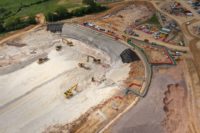Serious observers expressed great doubts about the viability of a plan by U.K. Prime Minister Boris Johnson for a fixed link between Scotland and Northern Ireland, that would cross an immense, bomb-filled deep sea valley. Confirming those doubts cost the government $1.2 million in studies he ordered, according to new official figures.
While creating the first link between the two nations had political attractions, the physical difficulty of creating the world's longest bridge or tunnel in such a hostile environment was always seen as a challenge too far.
Undaunted, Johnson in October 2020 ordered a review, done by leading engineers Douglas Oakervee and Gordon Masterton, with technical input by Jacobs U.K. Ltd. and COWI A.S. They confirmed early doubts before Christmas and the study cost was recently revealed
The major obstacle to the crossing is Beaufort’s Dyke, a subsea valley up to 3.5 km wide and 200-300 km deep running for 45 km roughly parallel to the coasts. A tunnel would be about 400 m below sea level under potentially dangerous 40 bar of water pressure. A bridge would need spans of an unprecedented 4 km.
Additionally, parts of the trench contain millions of tonnes of unexploded bombs and shells dumped from World War I until the 1970s.
Johnson's reviewers studied a corridor looping north of the dyke for a tunnel, in up to 200 m of water. Including the long approach ramps on either shore, the tunnel would be over 80 km long and cost $26 billion.
Since "technical immaturity" ruled out a floating tunnel while the great length and depth disqualified a sunken tube option, the engineers went for machine driven, twin tunnels with a central service bore.
For the roughly 30 km, multi-span suspension bridge option, the team chose a more direct route, crossing the dyke at its narrowest. It would cost $43 billion.
Including extensive approaches and other supporting infrastructure, the whole tunnel scheme would come in at up to $280 billion with $450 billion being the estimated cost of the bridge option. While technically feasible, the whole idea would be "impossible to justify," concluded the review, condemning the project for now.
The fixed link was the latest Johnson infrastructure ambition to flounder.
As mayor of London, he spent a reported $7 million to promote a major airport in the Thames Estuary, instead of the then proposed expansion of the city's Heathrow airport, which he opposed.
A specially convened government Airports Commission dismissed the estuary idea in 2014 on cost and environmental grounds. In 2016 the government approved a new, third runway at Heathrow.
A year later, Johnson's $250-million Garden Bridge plan for the River Thames was scrapped by the city's new mayor, Sadiq Khan, after more than $70 million had been spent on design and site investigations.
Promoted as a privately financed project, the deal set up by Johnson would have required the city to underwrite the cost of maintaining the 368 m long crossing in case the owner Garden Bridge Trust, failed to secure necessary financing, according to Khan.
In the end, the city and central government would have had to take on nearly all the up front cost of the supposedly privately financed, never-built, plant-laden structure.




Post a comment to this article
Report Abusive Comment